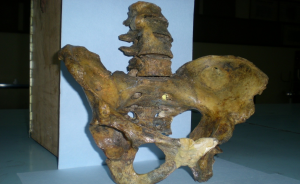International Journal of Anatomical Sciences 2010,1:34-36.
Case Report
Spondylitis Ossificans Ligamentosa of Lumbar Vertebrae
Najma M, Saraswathi G, Pushpalatha K, Malar D.
Department of Anatomy, JSS Medical College, JSS University, Mysore, Karnataka, India
Key Words: anterior longitudinal ligament, ossification, lumbar vertebrae.
Abstract: During the routine examination of dry and processed bones, it was observed that the bodies of second, third and fourth lumbar vertebrae were fused due to the ossification of anterior longitudinal ligament. The posterior longitudinal ligament, ligamentum flavum and intervertebral discs were spared from ossification in the same specimen. The ossification of anterior longitudinal ligament in lumbar region is not commonly seen as in cervical and thoracic regions. The ossification of anterior longitudinal ligament in the lumbar vertebrae has been considered a part of Diffuse Idiopathic Skeletal Hyperostosis – DISH (Forestier’s disease) Forestier’s disease most commonly affects obese men who are more than 40 years old and more so in North Americans. The prevalence of the disease has been estimated to range between 12 and 22% in men and 12 and 13% in women. Most patients have mild to moderate restriction of spine movements, low back pain and stiffness in the lumbosacral region (Burkus, 1999). By radiological studies three types of ossification of anterior longitudinal ligament have been described segmental, continuous and mixed types (Mizuno, 2005). The present study makes an attempt to establish the relation between the various types of ossification of anterior longitudinal ligaments in different regions of vertebral column and Forestier’s disease.
The axial skeleton of human vertebral column consists of 33 vertebrae. The vertebrae are held together by muscles and strong ligaments like anterior and posterior longitudinal ligaments. The anterior longitudinal ligament extends from the base of the skull to the sacral vertebrae (Chummy Sinnatamby, 1999). Its ossification is commonly seen in the cervical and thoracic regions, a condition rarely symptomatic and hence has not been widely described (Mizuno et al., 2005). In the present study the bodies of second, third and fourth lumbar vertebrae were fused due to ossification of anterior longitudinal ligament and hence the report.
Case Report
Data from routine examination of dry and processed bones in the department of Anatomy, JSS Medical College, Mysore was the basis for the present study. It was observed that the bodies of second, third and fourth lumbar vertebrae were fused due to ossification of the right anterolateral aspect of the anterior longitudinal ligament of lumbar vertebrae. It was noted that the height of the intervertebral disc spaces were preserved in the same specimen. The vertebrae of other regions were normal.
Fig. 1 Showing ossification of right anterolateral aspect of anterior longitudinal ligament of second, third and fourth lumbar vertebrae
Discussion
The ossification of anterior longitudinal ligament is considered as a part of diffuse idiopathic skeletal hyperostosis. Multisegmental ankylosis of vertebrae due to diffuse idiopathic skeletal hyperostosis – DISH (Forestier’s disease) commonly involves the thoracic and lumbar vertebrae. Forestier’s disease most commonly affects obese men who are more than 40 years old and more so in North Americans. The prevalence of the disease has been estimated to range between 12 and 22% in men and 12 and 13% in women. Most patients have mild to moderate restriction of spine movements, low back pain and stiffness in the lumbosacral region (Burkus and Denis,1994). By radiological studies three types of ossification of anterior longitudinal ligament have been described (Mizuno et al., 2005):
a. Segmental type: Partial or total ossification over a vertebral body without involving the disc space.
b. Continuous type: Ossification over many disc spaces as well as the vertebral bodies.
c. Mixed type: There’s a combination of the segmental and continuous types.
The present observation appears as continuous type. Diffuse idiopathic skeletal hyperostosis has been defined as ossification along the anterior to anterolateral aspect of vertebral bodies with the preservation of the height of the intervertebral disc spaces distinguishing it from the degenerative discogenic diseases (Mizuno et al., 2005). The Forestier’s disease is diagnosed and distinguished from ankylosing spondylitis, on the basis of several radiographic criteria: calcification and ossification along the anterolateral borders of vertebral bodies and preservation of the integrity of the intervertebral disc without diminution of disc space height (Burkus and Denis, 1994). The ossification pattern of diffuse idiopathic skeletal hyperostosis involves the anterior longitudinal ligament, the lateral portion of the annulus fibrosis, and the adjacent vertebral bodies. The involvement of sacroiliac joint is more common in ankylosing spodylitis with the ossification of anterior longitudinal ligament and decrease in the disc space height (Maheshwari, 2005).
Conclusion
In the present study it was observed that there was fusion of the right anterolateral aspect of the bodies of second, third and fourth lumbar vertebrae due to ossification of anterior longitudinal ligament and is a part of diffuse idiopathic skeletal hyperostosis which is a rare entity and hence this report.
Acknowledgement
The authors are grateful to the Professor and Head of the department Dr.N.M.Shama Sundar, JSS Medical College, Mysore, for his support and encouragement during the work. We are grateful to the JSS Medical College and JSS University for allowing us to publish our work.
References
Burkus JK, Denis F (1994) Hyperextension injuries of the thoracic spine in diffuse idiopathic skeletal hyperostosis. J Bone Joint Surg Am, 76:237-243.
Sinnatamby CS (1999) Last’s Anatomy-Regional and applied. 10414-421. Edition. UK: Churchill Livingstone
Maheshwari J(2005) Essential Orthopaedics Textbook. 3rd Edition. New Delhi: Mehta Publications Pvt Ltd. 248-249.
Mizuno J, Nakagawa H, Song J (2005) Symptomatic ossification of the anterior longitudinal ligament with stenosis of the cervical spine. J Bone Joint Surg Am, 87: 1375-1379.

